It’s magic.
Being able to grow your own fruits, flowers, and vegetables is one of the best feelings to have. But it can also be a lot of work.
There is the intense work of digging the soil, plucking out weeds, and watering the plants.
And what about the space?
Surely you need a ton of gardening space if you want to grow plants, right?
What can you do if you live in an apartment and don’t have a backyard garden? Is it time to give up on your dreams of enjoying fresh organic vegetables?
Don’t worry. Because there is a way to grow plants even if you have a limited space such as an apartment.
And you can do this with a lot less work than you would in a backyard garden.
What is container gardening?
Container gardening is a method of gardening where you can grow plants in a container. The container can be a box, tub, basket, barrel or anything suitable enough to hold a plant as it grows.
What are the benefits of container gardening?
Helps you grow plants in a limited space
Container gardening is great for glowing plants if you have a limited space. If you live in an apartment you can use container gardening to grow plants in your balcony or patio.
You could even keep the containers on your porch, lawn, or driveway if you only have that space.
You can get fresh vegetables and herbs for yourself as well as your pets like rabbits and guinea pigs.
Helps you grow plants if your garden has poor soil
You may have some space in your backyard but the problem could be the soil is in poor condition. Maybe it too rocky or sandy or maybe it contains some toxic materials dumped in it.
Container gardening can help you grow your own plants without worrying about fixing the soil.
Helps you grow plants without a lot of effort.
With container gardening, you have to manage less gardening space. And the plants are not going to be bothered with pests, diseases, and weeds as they would if you would plant them in the earth.
You can place your containers at a particular height in your balcony or on your kitchen table. This will help you work with them while standing or sitting.
Helps you grow plants without worrying about the weather
Some plants don’t enjoy the cold weather while others may not like too much rain.
With container gardening, you don’t have to worry about the weather if you want to grow your favorite plants.
Just place the containers in your house or move them inside when the weather turns unsuitable for them.
Read more:
How to choose the right pot for your plant
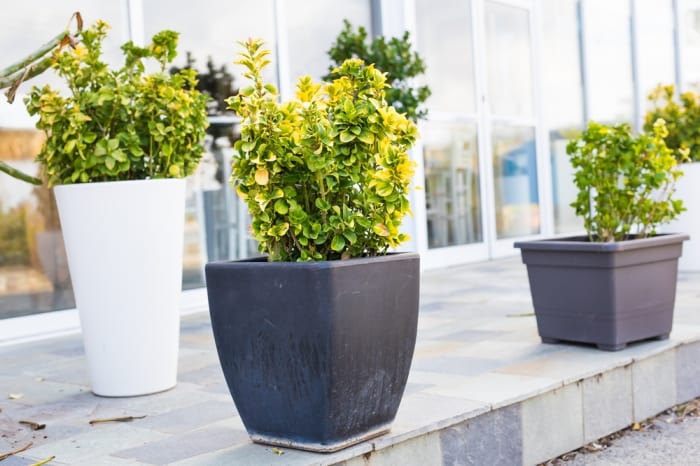
The type of container pot you choose for your plants depends on a few factors one being the type of plant.
Growing a vegetable or herb plant is different than growing an ornamental plant. They tend to be bigger and need more food and water to grow healthy and flavorful foliage and fruits.
Determine the water needs of the plant
The type of container you choose will depend a lot on the amount of water your plants need.
Plants are majorly made up of water and most of them especially vegetable plants need a lot of water. The hydrogen in water helps them make use of photosynthesis so they can make their own food using carbon dioxide from the air.
Water also sticks to the roots and helps to suck up nutrients from the soil. Otherwise, the roots would go dry and die. The essential microorganisms that are present in the soil and that help provide the plants with nutrients also need water to survive.
Plants use the method of transpiration to expend water from the stem and leaves. This helps create a system where the plants pull the water along with the nutrients from the soil and help them to grow healthy and produce fruit.
You can choose a traditional container pot that has a hole at the bottom to drain out excess water or you could choose a self-watering container that has an additional section that acts as a reservoir.
If you choose a traditional container you will have to do more work because once you water the plants they will use what is required and the excess water will drain out. The moisture in the soil will keep reducing till you again add water to the container.
You don’t have this problem with a self-watering container where there is a constant supply of water available to the plants as and when they need it.
Choose the size of the container
In a traditional container, the water is retained by the soil and the excess is drained out from the bottom.
This means the container itself acts as a reservoir that stores a certain amount of water. So the size of the container should be based on the size of the plant. The larger the plant the bigger the container you will need.
This is not the case for self-watering containers that has a separate section that acts as a water reservoir.
Buying a traditional container
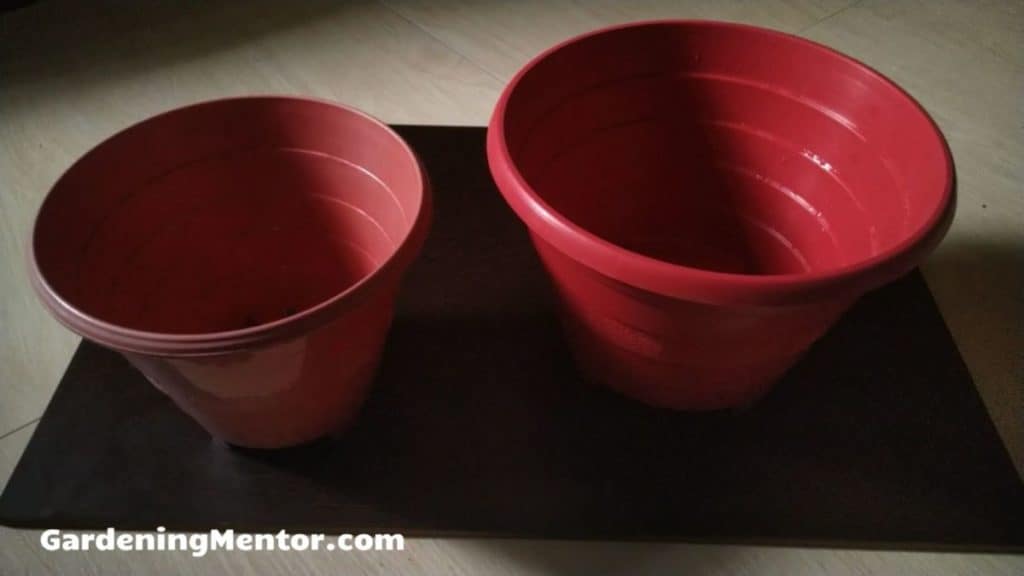
You can get a variety of container pots with different sizes, shapes, and colors at a hardware store or a garden center.
The materials used to make these pots can range from clay, metal, plastic, or fiberglass. Clay pots tend to be heavier than the other types. If you have a small plant you can get the clay ones but for larger plants, it’s good to get a pot that is lightweight and durable.
The cheapest ones are the plastic pots that are used in nurseries and garden centers. They don’t look as attractive but are inexpensive and durable.
You can reuse any old container you find in your house or maybe at a garage sale. This could be a plastic tub, a storage bin, or even a bucket.
All it needs to have is the right size that is fit for the type of plants you want to grow.
Then you need to make a hole in the bottom so that the excess water can drain out of it and it’s ready for your container gardening.
Buying a self-watering container
A self-watering container is one that has a section that holds water, a section that holds the plant and soil, and a separation between the two.
Such a container provides a constant supply of moisture to the roots that help them get the nutrients from the soil. This also provides moisture to the microorganisms in the soil that can produce such nutrients.
The plants can use the moisture in the process of photosynthesis to create the food that they need for growing healthy, tasty, and nutritious fruits.
Self-watering containers are a relatively new concept but they have been getting popular and you may be able to buy them at a garden center.
You can also easily build a self-watering container if you have the inclination to do so.
What material should you put in the container
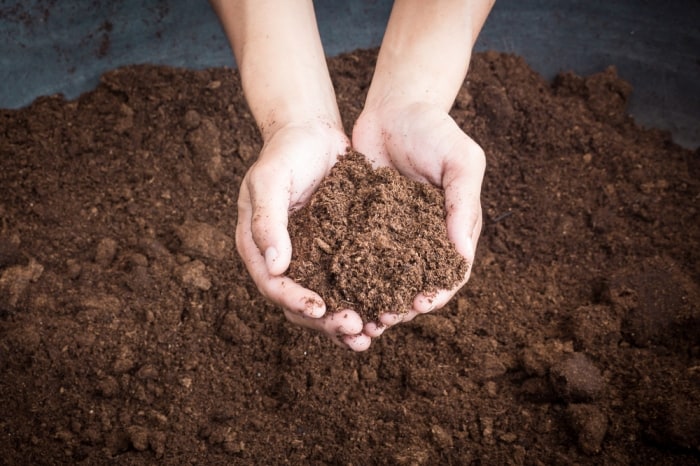
The most important factor for plants to grow in containers is the organic matter you put in the soil.
The soil needs to be rich in essential microorganisms that will provide the plants with adequate nutrients as well as make the soil suitable for air and water to move around.
Doing this requires a mix that is made from a good amount of compost that contains such essential microorganisms.
The material should contain sufficient pores
The fertile soil consists of rich nutritious matter as well as sufficient pores that allow air and water circulation.
The plants should be able to grow their roots in the soil and should not be prevented from doing so because the soil is compact.
The air in the soil also helps the plants pull in the nutrition from the soil through the roots. The water that percolates through the pores is used by the plants and microorganisms.
The air is also required by the essential microorganisms in the soil to survive and to provide nutrients for the plants.
Use the right potting mix for the containers
You might think to just buy some topsoil from the garden store and use that for your container gardening.
But the soil that you use in containers has to have sufficient structure to retain sufficient air and moisture, contain essential microorganisms, and provide sufficient nutrients to the plants.
For this to happen, you need to know what materials have gone into making the soil.
Topsoil from the garden may contain herbicides or pesticides you don’t know about. It may have a structure that compacts the soil and does not allow air and moisture to move through it. And it may not contain the essential organisms enough to provide sufficient nutrients to plants.
That is why it is important you know what goes into the container mix you are going to use. You can get some mix from the garden store and it might be called as potting mix, potting soil, container mix, or something else. But remember to understand what it contains.
You want a mixture that contains some amounts of peat moss, perlite, limestone, and vermiculite.
Peat moss has a structure that will help retain moisture and decompose slowly while perlite has a structure that will allow air and water to move around. Limestone helps to balance the acidity provided by peat moss and also some magnesium.
Add some fertilizer to your container mix
Plants will get the hydrogen, oxygen, and carbon from the air and water made available through the texture of the potting mix.
However, plants also need essential macronutrients like nitrogen, potassium, and phosphorus as well as micronutrients like calcium, magnesium, boron, iron, and several others.
You can do a soil test to find out whether your soil is lacking in the macronutrients and if that is the case you can use the appropriate fertilizer. The fertilizers have the NPK values mentioned on them which indicate the amount of nitrogen, phosphorus, and potassium it contains.
Nitrogen will help the plants with photosynthesis and protein synthesis. Potassium helps starch formation and protects the plants from stress and diseases. And potassium helps the fruits, flowers, and seeds to grow as well as increases resistance to diseases.
When you start container gardening you can add a balanced fertilizer that contains an equal amount of nitrogen, phosphorus, and potassium to the potting mix.
Add essential compost to your potting mix
Even with the fertilizer, your soil will not get all that is needed and that is where compost comes it.
The compost will help provide the soil with the essential microorganisms and the food that they need. These microorganisms will be consumed by other organisms and the excreted product provides rich macronutrients and micronutrients that the plants need.
The compost also makes the soil texture able to move air and water through it so it is available to the plants as well as the microorganisms.
The compost is also able to retain a lot of moisture that the plants need while draining out the excess.
Compost will help balance the pH level of the soil and make it more suitable for the plants to survive. It will also change the composition of the soil whether it is too sandy or has a lot of clay, or silt. It will make the composition suitable for allowing good movement of air and water.
If you make your own compost you can use different types of organic waste such as dry leaves, grass clippings, kitchen waste and you don’t need to worry about disposing of that stuff.
You can either create your own compost or buy some ready made compost from a garden store.
What are some tools you may need for container gardening
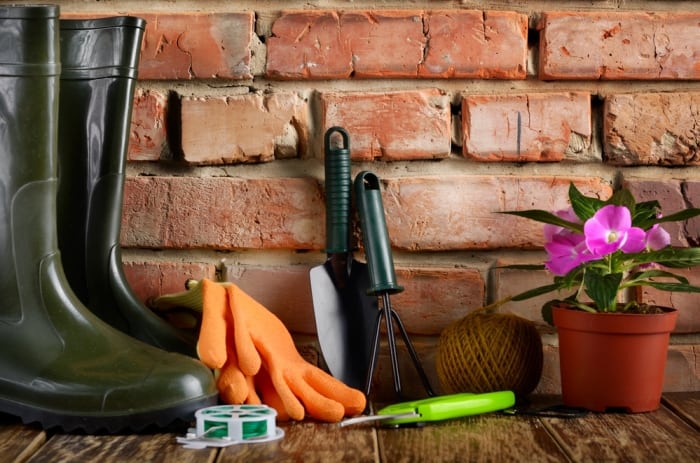
You won’t need as many tools for container gardening as you would need for earth gardening. And the tools could easily fit into an apron or a small bag.
Gloves
Gloves come in handy when you want to work in the garden and protect your hands from getting dirty or abrased.
You can get gloves that are either waterproof, semi-waterproof or non-waterproof.
The non-waterproof variety is made of fabric and only used when you are doing work such as pruning or harvesting and won’t protect your hands from getting wet and dirty if you use them to mix container soil.
The semi-waterproof gloves have a rubber coating on the palm end so that you can do work like transplanting without worrying about your hands getting wet. They are not used for mixing container soil where you need to use your full hands.
The waterproof gloves are fully coated with rubber so that your hands remain dry when you are doing work such as mixing moist container soil.
Trowels
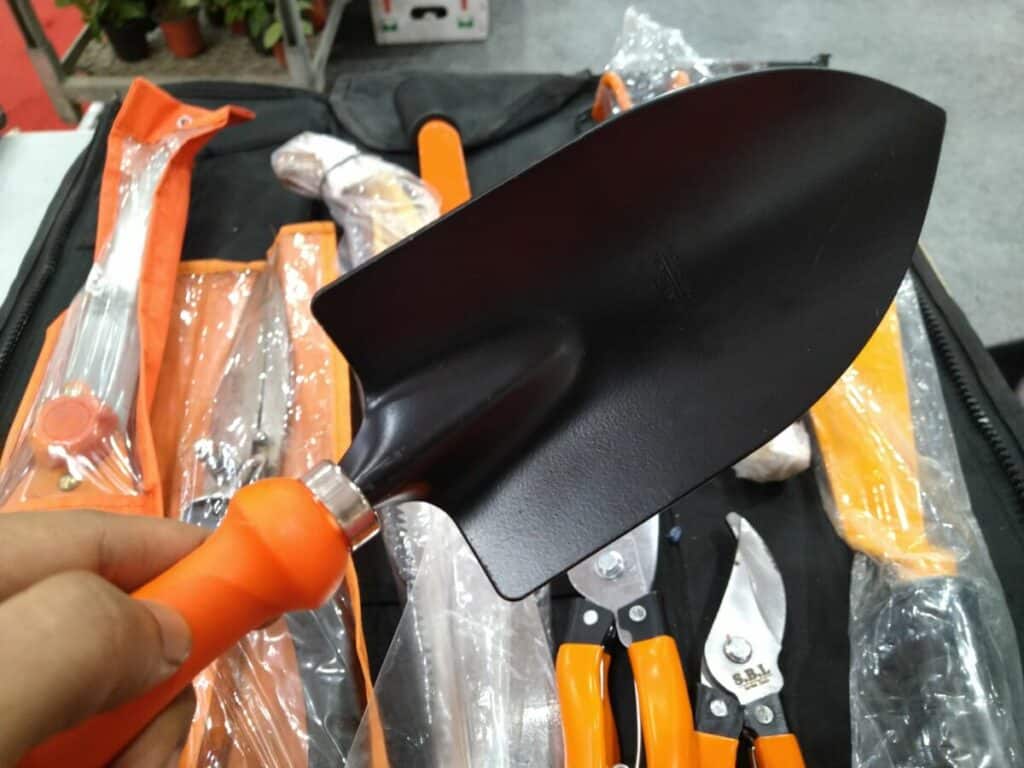
The soil that you have in containers is going to be loose and friable unlike those you would get in an outdoor garden.
This means you don’t have to use the trowel as often because your hand can do the work of digging into the loose container soil.
There are some occasions where you may need to use the trowel but you then need a smaller one than what is available for most outdoor gardening.
Cutting tools
When you want to prune some leaves, stems or harvest some flowers and vegetables, your hand should be sufficient to do the job.
However, if you have sensitive hands and don’t want to get them dirty you can consider using a pair of floral scissors that can get the job done easily.
In case you are growing vegetables like lettuce you can cut the heads using a simple serrated knife you can buy at a hardware store.
If you want to trim branches that are hard to reach and too thick to cut with your hands you can consider using pruning shears that will make the effort easy. They would also be useful to cut off plants that are dead at the end of the season and have become hard.
Basket
A harvest basket is useful for carrying around your seed packets, books, and tools if required. It’s also useful to harvest the fruits, flowers, and vegetables during the harvest season.
Watering tools
The plants in your container garden are going to need a lot of water and the rains are not going to provide all of it.
If you are using the traditional container pots you will need to water them frequently to provide the plants with the water they need. In case of a self-watering container, you need to keep the reservoir filled so that the plants can take up the water they need.
You could use a watering can to water the container pots or fill the tubes of the self-watering containers. You may need to use a funnel or an attachment to be able to fill the tubes.

You could also consider using a gardening hose to water your containers. You can keep the containers near to a faucet where you attach the hose. Or you can have a coiled hose move from inside the house through a window to the containers.
It would be good to get a hose that comes with a handle that turns the water on and off because it will help you water the containers and not pour water on to your patio or balcony.
Measuring tools
Measuring tools will help you know what is going on in the air and soil that your plants are in.
A regular thermometer will let you know the air temperature when you check it during the day. But many plants are unable to survive because the night temperature drops way below the day temperature. That is why you need a min-max thermometer that will record the night and day temperature and help you make a decision whether you should move the plant container outdoors.
You also need a soil thermometer that will help you know the temperature of the soil. This is useful to plant seeds and seedlings when the soil temperature is just right. You should be careful to measure the soil temperature at the right depth you need. A measurement at 1-inch depth will be a lot different than a measurement at a 3-inch depth.
Supporting tools
Some plants like to climb and you will need to provide support to them.
In an outdoor garden, this means you need to use a stake or a trellis so that the plants can climb on them. However, using these is more difficult in a container garden.
The soil of the containers is loose and soft which means they cannot support the weight of the stakes and the plant on them.
You need to either attach the stake to the container itself or need to drive the stake into the ground next to the container if you have a garden.
If you have your containers on a patio or balcony you will need special containers that come with a stake or trellis attachment through the container.
How can you get started with container gardening?

There are some things you should consider while starting with container gardening as they will help you have fun while being able to grow your favorite plants.
Start with a few containers in the beginning
Most of the time container gardening will need less effort than earth gardening. Container gardening does not need the digging or weeding. Plants grown in containers are also less susceptible to pests and diseases.
However, plants in containers need a lot more water than plants in the ground. This is because plants in the ground can spread deep and wide into the soil and get their moisture from it. But the plants in containers have a limited amount of soil that can dry quickly.
It does not matter whether you use the traditional container or a self-watering container, you will need to monitor it for the water content and keep providing water as needed.
The problem is the more the number of containers you have the more time you will need to spend on watering them. So, in the beginning, it’s best that you start with a small number of containers.
And as you get experienced, you will be able to increase the number of containers based on the level of fun you’re having and the time you can spend on the container gardening.
Decide what plants you will be planting in the containers
Now that you’ve decided to grow a few plants in containers you need to choose the type of plants you will grow.
If you are growing vegetables you may find that some vegetables taste the same whether you buy them at the store or harvest them fresh from the garden.
But there are other vegetables that taste way better when you harvest them fresh from the garden instead of buying from a store. And these are the vegetables you should consider growing in your containers.
The type of vegetables you may grow also depends on the yield of the plants. It’s much better to grow a tomato plant that yields 20 to 30 pounds of tomatoes than an artichoke plant that may give you a yield of half a dozen artichokes.
The same could be said of growing leafy greens like spinach or kale which you can harvest almost every day but if you grow onions you’ll have a limited harvest.
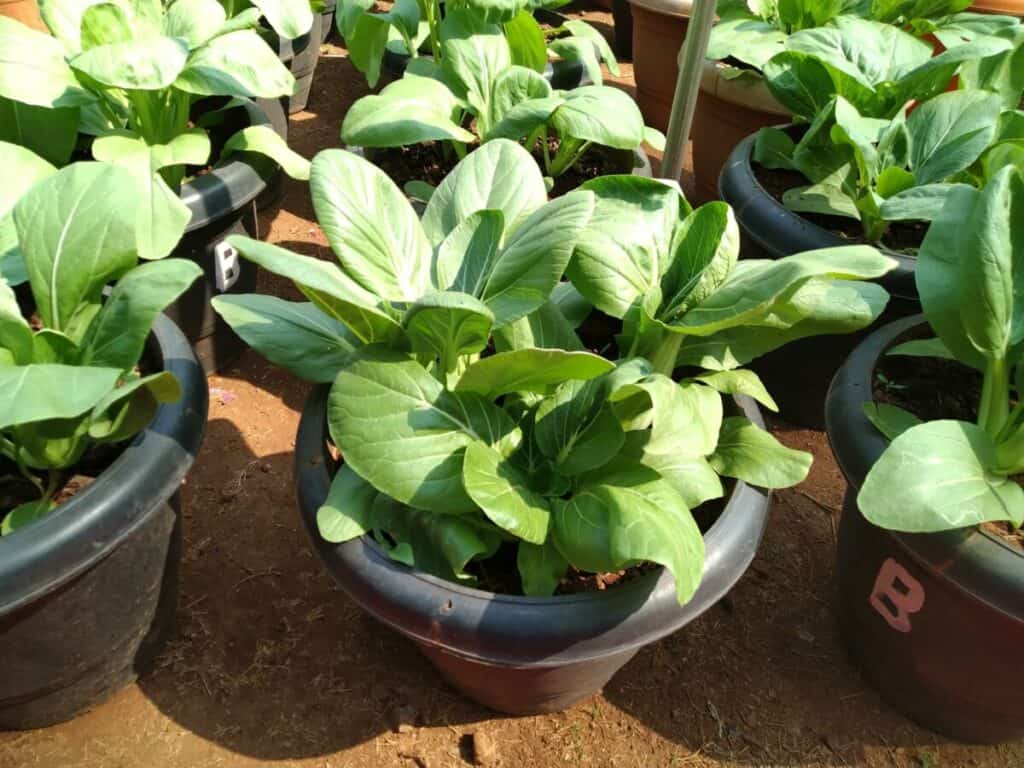
You should also decide to grow plants that are not commonly available in the stores. So for vegetables, you have the option to grow varieties that are not available commercially. Because commercial vegetables are limited to those that are easy to transport and last longer but usually at the cost of the taste.
And finally, your choice of growing plants should be based on the area where you will place the containers. If the containers are going to get a lot of light then you can plant almost any plant in them. But if they are only going to get a limited amount of sun you need to choose plants that survive in such a condition.
Decide the location where you will place the containers
There are some plants that need shade from the sun, some that are tolerant to getting a little sun, and others that need a full day of sun to grow.
These factors should be used to decide where you keep the containers for your plants. If you have plants like tomatoes, peppers, or eggplants, they need at least 6 hours of sun every day.
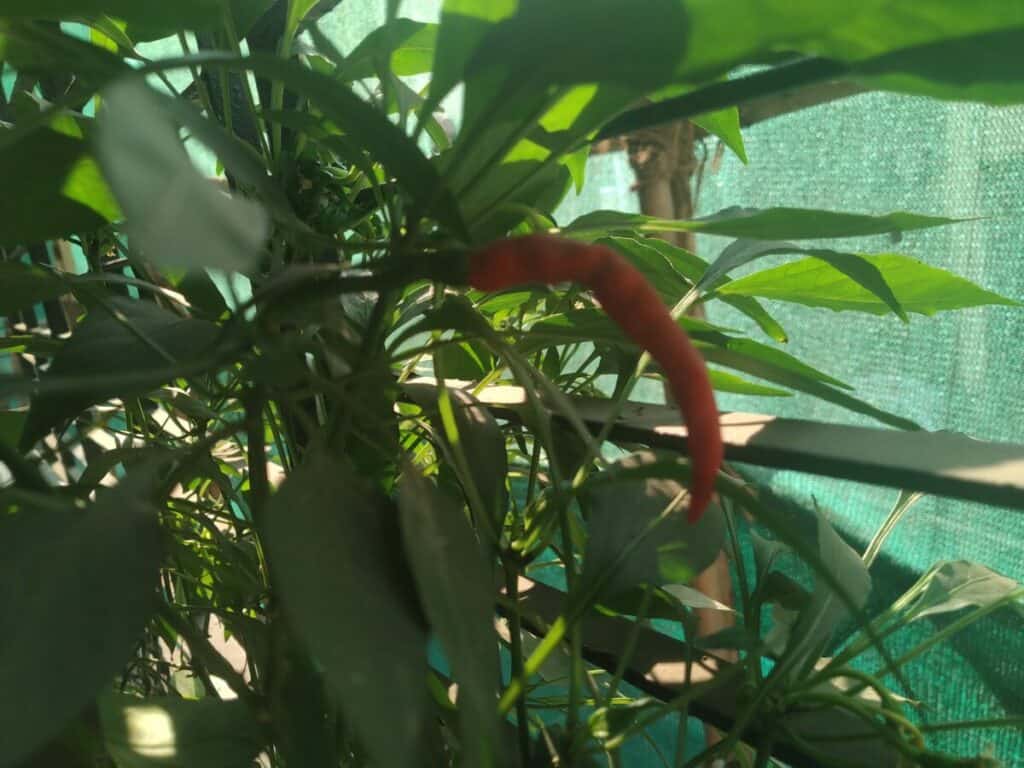
But if you have shade-loving plants like spinach or kale you can get by with a minimal amount of sunlight on your containers.
But it has been found that most plants even if they are shade loving grow much better when they get plenty of sunlight. This is because the sun helps the green leaves to use photosynthesis and extract hydrogen from water and carbon from carbon dioxide in the air. The hydrogen and carbon are then combined to produce carbohydrates that are the basic food for plants.
You do need to be careful to provide ample water to plants that are placed in the sun because the soil will dry out quickly. It would be good to place the containers in a location where water is easily accessible.
Maybe you can have a hose available near the containers that will make it easy to water the containers every day as required.
Choose the containers with the right size for your plants
The size of the container you use depends on the type of plants you are going to plant.
If you have small plants like basil you can get by with a small container. However, it’s always better to go for a large container where you can plant a bigger plant or several of the smaller plants.
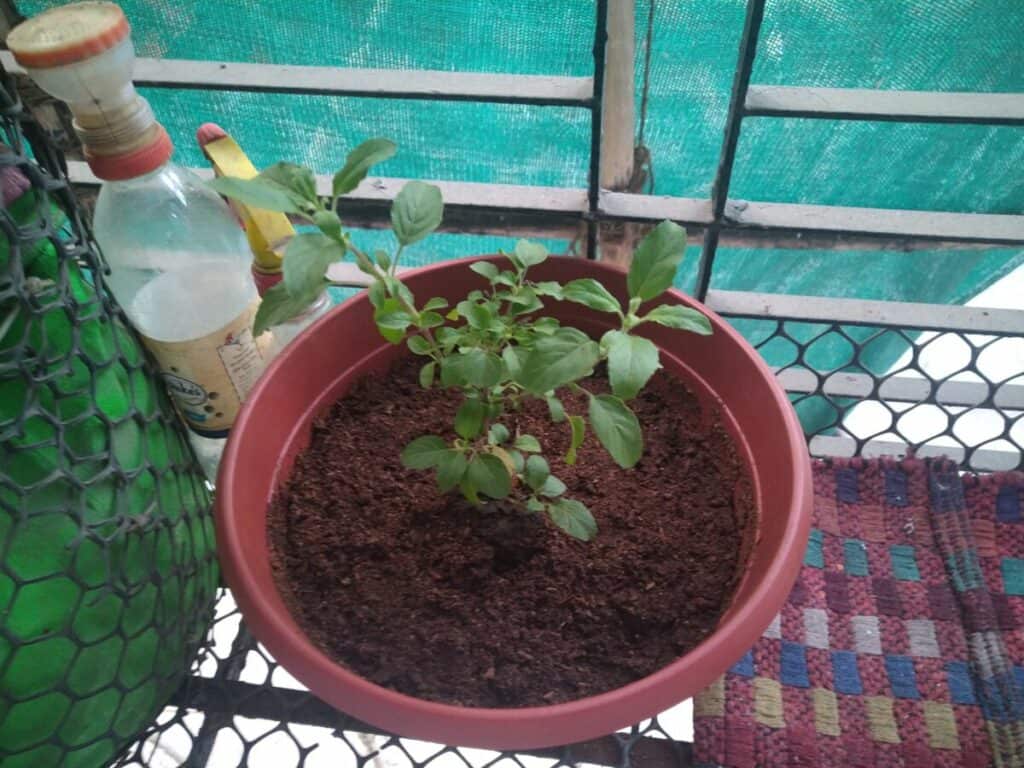
If you’re going to plant an indeterminate variety of a tomato plant you will need a large container. If it’s a self-watering container it should have a reservoir of at least a few gallons.
This is also helpful when you are away on vacation and can fill the reservoir with some extra water that the plants can use in your absence.
If you have smaller plants still you should consider using containers with a good sized reservoir to hold ample of water.
If you are planting root vegetables like carrots or beets you will need a container that has a depth of 10 to 12 inches.
How can you start the plants in your container garden?
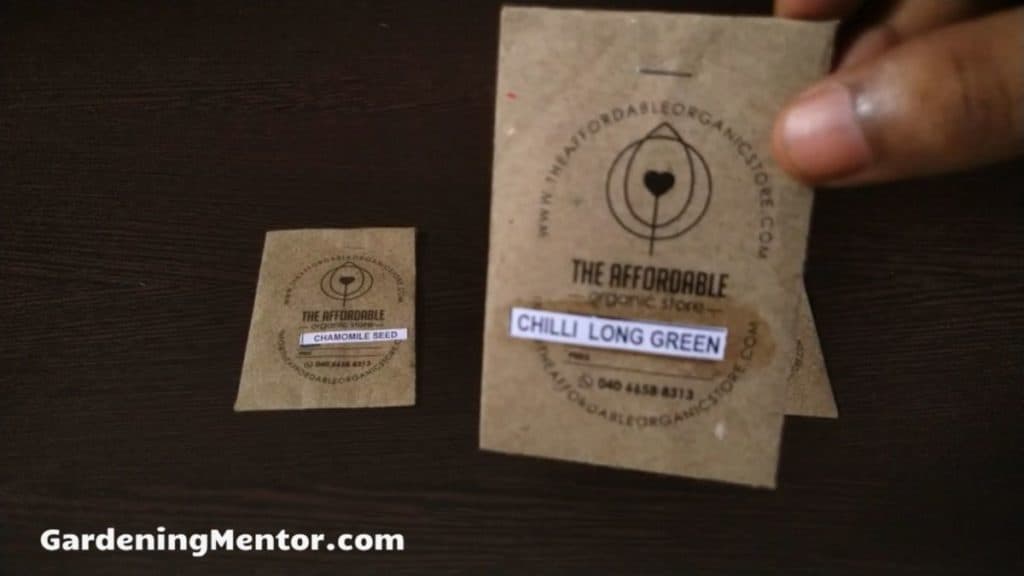
For your container garden, you have the option to either grow the plants from seeds or to buy the young plants from a garden center or a greenhouse.
If you are planting in the ground you will find it a lot cheaper to buy seed packets because you will be planting almost all of them. However, for your containers, you are only going to plant one plant in each container which is cheaper to buy than getting a full packet of seeds you’re not going to use.
Buying your container plants
You can get some healthy, well-growing plants from a greenhouse or garden center but you do need to be careful otherwise you will end up with weak and stressed plants.
It’s better to get plants that are growing in a 4-inch container rather than smaller ones because that gives them plenty of room to grow in the soil before you transplant them.
Check that the plants you buy are growing well and don’t have pests and diseases like aphids beneath the leaves.
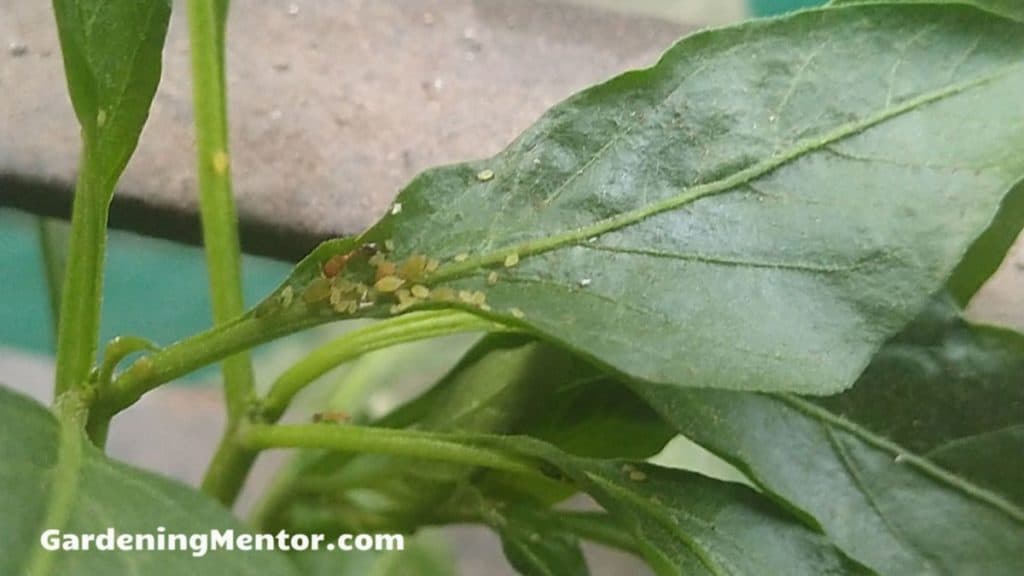
Check that the leaves of the plant are dark green because pale leaves are usually an indication of a lack of nitrogen.
If you can manage to keep the plants indoors for a few weeks before planting then it’s a good option to buy the plants a lot early when they are very young. That’s because you can take care of the plants much better than at the garden center or greenhouse and they will be in a good condition when you want to transplant them in your container garden.
If you cannot manage to buy the plants early and keep them indoors then you need to harden the plants by adjusting them to the outdoor environment a little at a time. You can start keeping them out for an hour in the shade, then for two hours the next day, and so on. And then you can move them in the sun for an hour before moving them in the shade. And keep increasing the duration so that the plants can get accustomed to the wind and the sun for a full day before you plant them in the containers outside.
Starting your container plants from seeds
You can start container plants from seeds when you want to know how the plants grow, what food they have had, what soil they have been planted in, and when exactly they are ready for transplanting.
It’s not a difficult task but it can take a lot more of your time and attention.
There are some seeds that need to be started indoors by giving them a lot of care. While there are other seeds that don’t find any difference whether you grow them indoors or outdoors.
You do need to provide some essentials to the seeds whether you plant them indoors or outdoors.
You can use any container for starting the seeds such as coffee cups, cans, milk cartons, egg cartons, or yogurt containers. Or you can buy pots from the stores that are made of plastic or peat.
Some seeds like melon, eggplant, and peppers need a good amount of heat for germinating well. This could be as high as 28-30 degrees Celcius. You can provide the seeds with such warmth by placing a heating mat made of plastic or rubber underneath the seed cups.
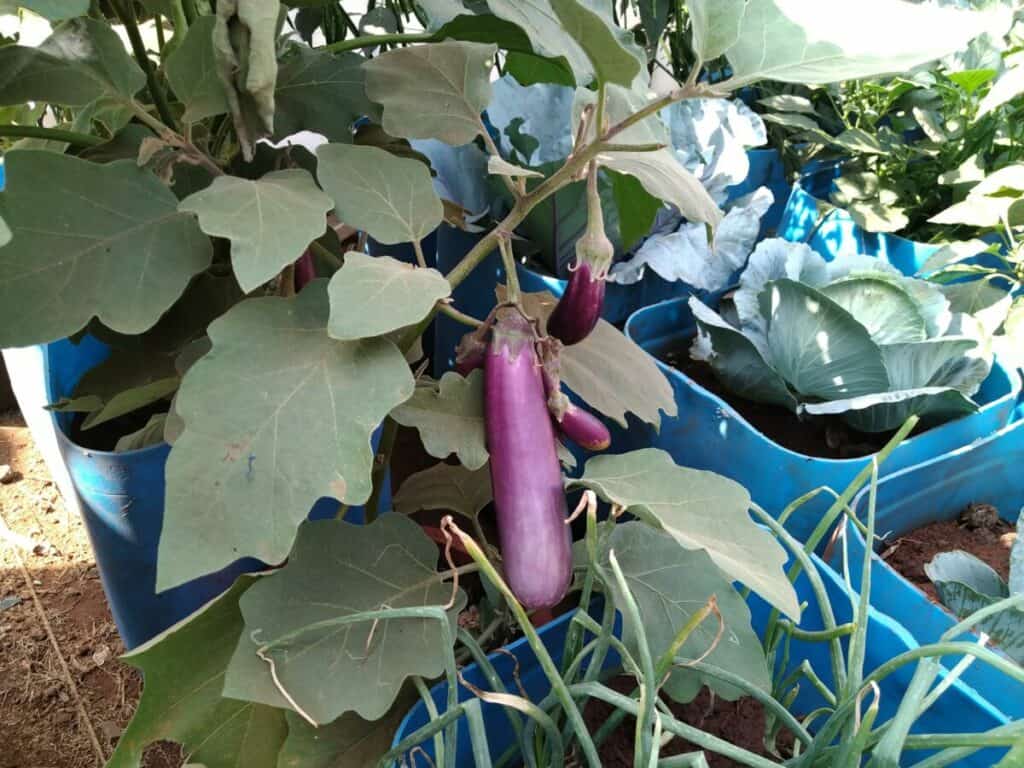
Seedlings need a lot of light and you can provide this by keeping them near a window and turning them regularly. But a better option is to install a fluorescent light about 3-4 inches above the seedlings. The lights and the electricity will cost a bit more but it seems to be worth it.
You need to be careful and provide ample water for the seedlings. If you have a self-watering seedling container you need to keep the reservoir full of water. If it’s a regular container you should ensure that the soil is not getting dry.
You also need to provide the right food to the seedlings. If you are using compost for the soil then most nutrients will be available from that. But if you are using a regular seedling mix then you need to provide fertilizer every week. You could use a liquid fertilizer that you mix with water and add to the seedlings.
How to take care of your container garden?
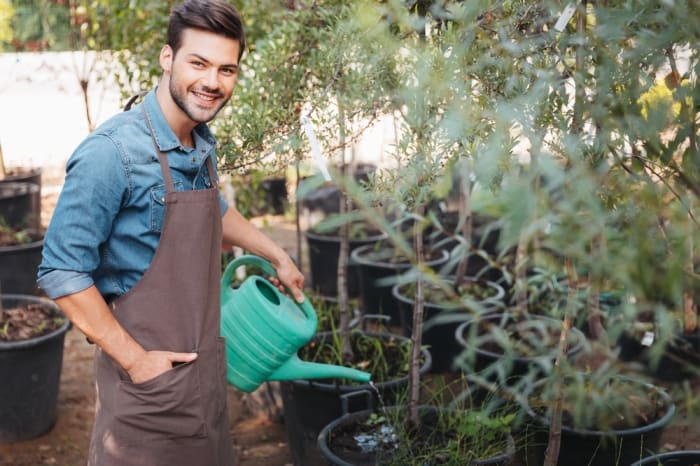
It’s a lot less effort to take care of your container garden than it would be for an earth garden. You don’t need to worry about cultivating the soil, pulling out weeds, or dealing with diseases. However, you still do need to do some work such as watering the plants, feeding the plants, and protecting them from pests.
How to water the containers
Water is very essential for the growth of plants in containers. Without water the roots will not grow, the plants cannot absorb nutrients from the soil, and the essential microorganisms will not be able to survive.
The plants in containers have a limited amount of soil to grow. And this means the water that the soil can hold is also limited. So you need to provide a lot of water to your container plants. A lot more than you would for your earth garden.
Watering traditional containers
If you have your container garden using the traditional containers you’re going to need to water them a lot.
The soil in traditional containers has the optimal moisture just after you have watered the container. But once the plants are utilizing the water in the soil, the moisture content keeps dropping till the soil becomes dry.
So you’ll need to provide water to such containers two or three times a day depending on the plants and how hot the weather is.
This is the reason it’s not recommended to use the traditional containers as it takes a lot of effort and even then the plants are not getting water all the time when they need it.
Watering self-watering containers
It’s better to use self-watering containers for your container garden but that does not mean you don’t need to water your plants often. It just means you need to water your plants as often because with self-watering containers the plants will be getting some water when they need it.
You do need to keep an eye on the reservoirs of the containers to see that they don’t get empty and you need to refill them maybe every day or every other day. This depends on how much water the plant is using based on the type of plant, the growth state of the plant, and the weather.
You may need to fill water every other day for a seedling but for a full-grown plant you may need to water every day. For a water-hungry plant like summer squash, you may need to add water to the reservoir twice a day if needed.
How to know when the plants need water
You can use a moisture meter to measure the moisture in the soil and determine whether the soil needs water.
But you could also take a look at the soil by sticking your finger in it and checking how wet it is. If it turns dry you need to add water to the soil so that it turns moist enough.
If the soil in the self-watering container has turned dry then it won’t work if you just add water to the reservoir. This is because the soil has lost its ability to wick moisture. You will need to water the soil from the top till it is moist enough and water is dripping into the reservoir. Then you can fill up the reservoir.
Read more:
The Ultimate Guide To Water Plants In Containers
How to fertilize the soil in containers
If you have provided your container mix with good compost it should be sufficient to provide the required nutrients to the plants.
But if you just use regular compost mix you are going to need to fertilize the soil depending on your container.
If you have a traditional container you may have to add fertilizer every other week. This is because when you water the container from the top several nutrients will leach out from the bottom of the container with the excess water.
You won’t have this problem with self-watering containers and you don’t need to add fertilizer as often. Maybe every 6 weeks or so you can consider adding fertilizer depending on how well the plants are doing.
If you find that the leaves of the plants are turning pale green or yellow it means there is a lack of nitrogen. If you find the leaves turning purple it is a lack of phosphorus.
It’s good to use organic liquid fertilizer such as fish emulsion and seaweed that is rich in nitrogen, phosphorus, and potassium as well as several micronutrients essential for the plants. If you use compost tea as well it will also provide the soil with the essential microorganisms.
Don’t use a granular fertilizer because it’s difficult to mix such fertilizer in the soil without damaging the roots of the plants especially in self-watering containers where the roots are not required to be very deep.
How to prune the plants in containers
The main intention of plants is to grow several leaves and branches, then grow flowers on those branches, and finally fruits that produce seeds.
But as gardeners, we don’t always want the flowers, fruits, and seeds especially if it’s a herb plant. So we need to prune the tips of the branches before they can spring flowers. The plants then respond by growing more branches so they can grow more leaves and hence more flowers which is what we want.
Some plants like varieties of indeterminate tomatoes will keep growing as long as they want. They are vines that want to crawl all around the place while growing as many suckers and as many flowers and fruits from those suckers as possible.
The problem is such plants don’t care what season is about to come. Autumn and winter may be just around the corner but they will still keep growing fruits and flowers that will never reach maturity.
This means the fruits and flowers that are growing are of no use and sapping unwanted energy from the plants and you need to prune them so the plant can focus energy on the existing fruits.
Another reason to prune the plants is when you have them growing on a stake or trellis and they are producing a lot of branches. If not pruned the branches will go out of control and you will no longer be able to maintain the plant on a trellis.
It could also be that the plant has got so many branches that it’s producing a ton of fruit on the top and the plant can break or topple over due to being top-heavy. So it’s important to prune the main stem as well as the branches before such a situation can occur.
How to protect your container garden from pests and diseases?
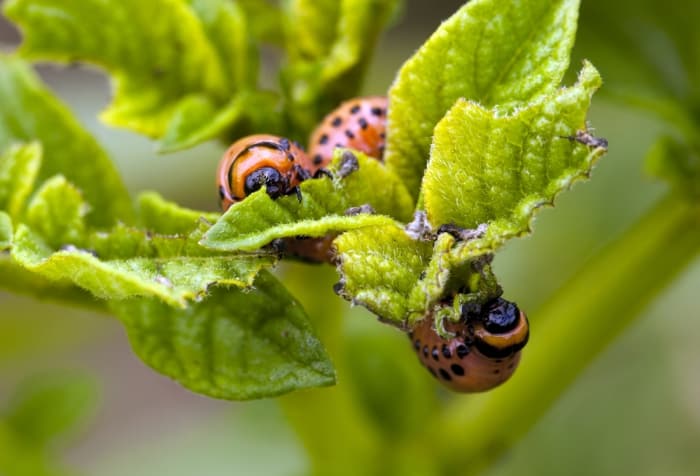
You won’t face as many pests and disease problems in a container garden as you would in an earth garden.
Many pests don’t bother coming to the balcony or patio in search of food because they are not familiar with those places.
Many diseases that affect plants develop from garden soil but you won’t be using any in your containers. You will be using a mix of compost and container mix in your garden which will help you prevent several such diseases.
Plants can get blossom-end rot if too much water is provided to them. But if you’re using self-watering containers this is not going to be a problem you will face.
There will be some pests you will need to deal with. But even those might not cause extensive damage to the plants. Maybe they will eat a few leaves and you may notice some holes in them. But that does not mean your plants are in danger. It’s common in nature to have some pests that eat a few leaves but the plants are strong enough to deal with such damage and keep producing leaves, flowers, and fruits.
You need to be careful if you get your plants from a garden center or a nursery. Pests like aphids may be lurking beneath the leaves and you should be able to see them. You should also check the plants for any damage due to pests and if so avoid buying them.
Getting useful predators in your container garden
You could put some useful predators in your containers that will eat up the pests. This could be something like ladybugs, lacewings, or praying mantises. But you need to be careful with the numbers you use.
If you use too many of them they will eat up all of the pests and move away from your containers for lack of food. This will brings the pests back and you’ll need to add more of such predators.
So you need to keep the right balance of pests and predators in your containers so the pests are minimal while the predators are getting their food supply.
You can buy a supply of such useful predators but you could also attract them to your container garden. To do so you need plants that provide the pollen and nectar that these creatures enjoy.
Plants like coriander, nasturtium, morning glory, and caraway are some such plants that tend to attract the predatory insects.
Using organic methods to protect your garden from pests
You can use some sort of barriers like row covers or repellents to protect your plants from pests.
The simplest way to take care of pests is to routinely check each plant in your container garden for such pests and handpick them.
You could use organic pesticides such as those that include neem but that should be a last resort. Even though it is organic, a pesticide still kills organisms which could include the beneficial microorganisms as well as the predatory insects that are our allies.

In earth gardens, you can use crop rotation where you change the plants in a particular garden bed every 2 years with another category of plants. This helps eliminate diseases in the soil as well as get rid of pests.
In container gardening, you can do something similar after the growing season is over. You can dump the contents of the container and wash the containers with 1 part bleach and 9 parts water.
You can then add a fresh batch of container soil and compost in the containers and start your planting for the next growing season.
How to protect your garden from the big pests
It takes a lot of small insects and a lot of time for them to damage the plants in containers. However, a big pest can damage your plants overnight.
Deer could chomp away at your plants and vegetables in a matter of hours. It could even be your pets like dogs that may take a liking to some plants and damage them.
Cats may think that the container is a litter and mess them up. Squirrels could dig into your container soil thinking it a safe place to store their nuts and in the process dig up your seeds and seedlings.
Using repellents to protect your plants
You may be able to get repellents at your local garden center that are supposed to keep such big pests away. This could be something like blood meal or human hair or predator urine.
Some are based on smell while some are based on taste which means the animals will eat up the plants before moving away. You should also know that some of these repellents cannot be used on edible plants as they will taste bad.
Using repellents seems like a temporary measure because animals get used to them and then they become ineffective.
Using a fence to protect your plants
The fence is your best protection when it comes to big pests. The best option when it comes to fencing is to use an electric one which keeps most animals away.
But it’s an overkill if you just have one or two containers in your garden. Or maybe your neighborhood does not allow using such a fence.
In such a situation you can use a fence made of chicken wire or plastic mesh. A fence of about 4 feet should be sufficient to keep small animals out. But this won’t work for larger ones like deer and you’ll need to use a covered fence.
How to prepare your containers for the cold season
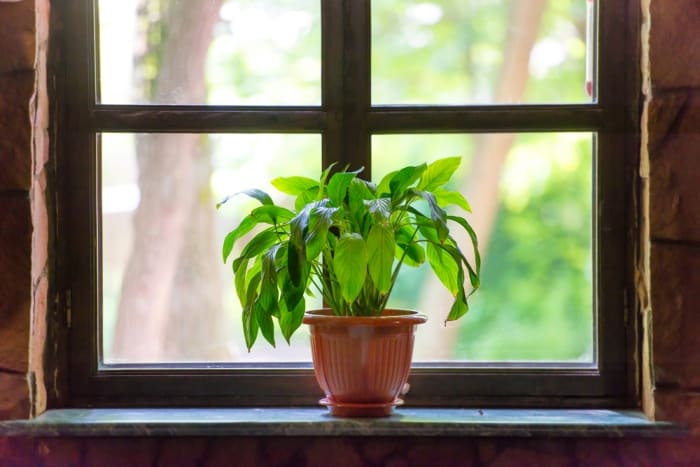
Once the winter season approaches your container garden will also start to become inactive. There are some things you can do as this cold season approaches to help plants survive and perhaps continue till the next growing season.
Cover up your plants
Like the earth gardening, you have the option to cover up the plants in your containers. This protects the plants from a few degrees of frost depending on the thickness of the cover.
The cover is made up of woven fabric and the thicker the fabric the more degrees of cold the plants can survive.
Just make sure that the cover does not come in contact with the plants because if so that area of the plant will start to freeze. You can make use of a frame around your plant and let the cover reset on that frame.
Move your plants indoors
When the temperature drops below a certain level, covers won’t be able to help your plants. But you can help them survive by moving them indoors.
If your containers are light you can move them or you might need a few helping hands to do so. An easy way to move containers is to keep them in a trolley so the moving around becomes easy.
Even if you can’t move the containers in a warm area of your house it’s good enough to move them in a garage or shed. The temperature in these places is a lot warmer than outside and while your plants won’t grow they won’t die either because they will go to a hibernate state.
If your plants are mature enough they will even survive without the light in such areas. But you cannot expect to grow plants from seeds without the light and heat.
Once the growing season arrives you can put the containers back into the outdoors and the plants will again spring back to life.
Take care of your containers
The easiest thing you can do with your containers during winter is to leave them outside with the soil still in them. This will allow the microorganisms to eat away at the roots and loosen the soil so you can remove it in spring.
The problem with this could be that your containers might get damaged due to the freezing and thawing that takes place. You could avoid this problem by using plastic, fiberglass, or wood containers instead of terracota ones.
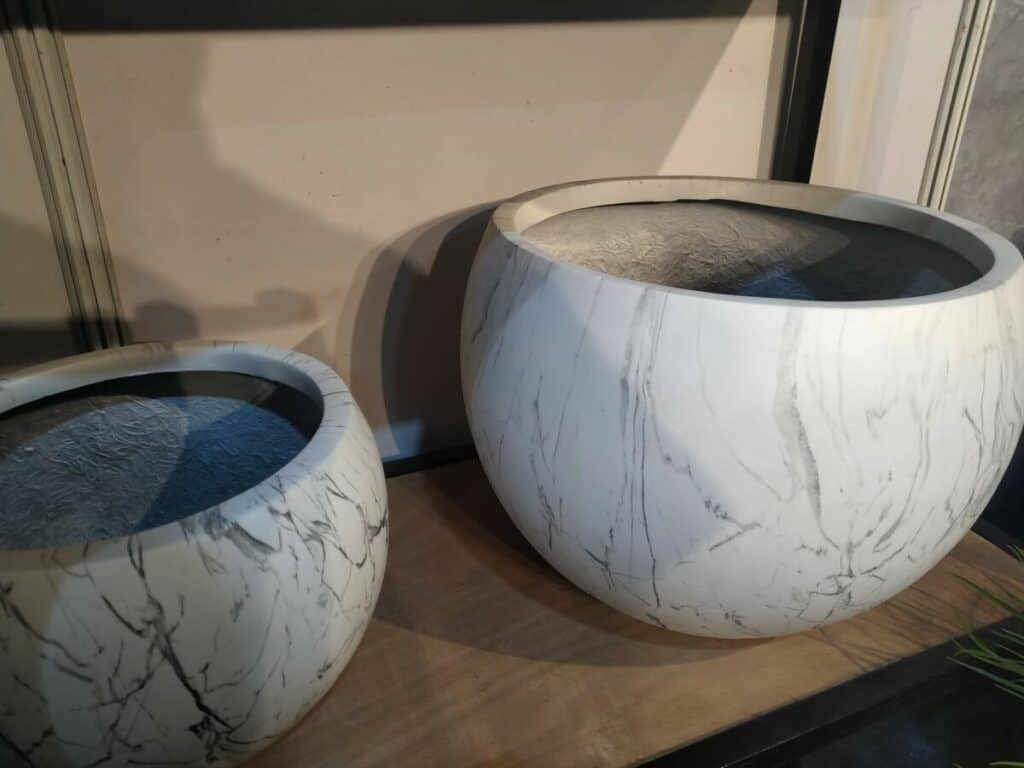
The other option is to dump the soil out of the containers and store them in a garbage bag. Then wash the containers with soap and water and store them in your garage for the growing season.
You could even leave the soil in the containers till the growing season. Then take it out, remove any roots and mix fertilizer and compost in it to get it ready for the growing season.
Reuse the soil in your containers
You don’t need to throw away the soil once winter season starts. You can remove the soil from the containers and store it in a garbage bag or leave it in the containers until spring.
Once spring arrives you can take out the soil and loosen it up. If there were roots in the soil they would have rotted away in the winter. If there are any clumps of soil you can add moisture so that they loosen up.
Your soil will have lost some nutrients during the previous growing season. The microorganisms will have used up some portion of the compost to create nutrients that your plants used up.
So you will have to replace the amount of compost that has been used up. You may also need to add fertilizer to the soil based on what is lacking in it.
Time to start your own container garden
Now you can enjoy the benefits of owning a garden even if you just have a small space on your balcony or patio.
You can do this without spending hours digging the soil, plucking the weeds or taking care of pests and diseases.
So put on your gardening hat, get some containers, and start growing your favorite plants.
Because a house with a garden is worth living in.
I would suggest growing your own vegetables in containers as you get the benefits of growing a container garden and harvesting food. Check out the post below that will help you learn the basics of building up such a garden.

Fact Checked, Written, and Published by Kevin Rodrigues
Kevin is the founder of Gardening Mentor, a website that aims to teach people to grow their own food in a limited space. As a self-taught gardener, Kevin has spent several years growing plants and creating gardening content on the website. He is certified in Home Horticulture and Organic Gardening from Oregon State University. He has a Post Graduate Diploma in Horticulture and Landscape Gardening from Mumbai University.
Read more

Thanks for the detailed article. Amazing how we can enjoy a garden with minimum space.
“Container Garden” —– Gardening Mentor – Kevin – you rock!
Hi Maggie,
Thank you for the comment.
Thanks for this massive guide Kevin, it was really useful to read. We’ve recently had to pave over a large portion of our front garden and I’m keen to add some greenery back in with some potted plants. I’d need some big pots to properly fill the space and I’m still trying to decide what to put in then, but this guide has given me a lot to think about.
Thanks again, it must have taken you ages to put together!
Hey Kevin,
Thanks for your comment. Glad that you found it useful to get going with your container garden.
Yes, it took me some time but I learned a lot about container gardening while doing the research.